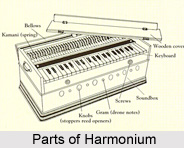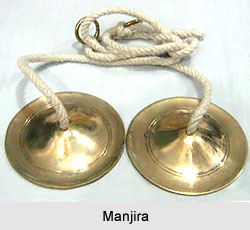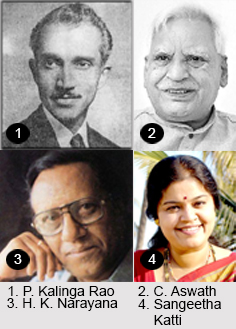 Construction of harmoniums is actually a process that leads to the making of this popular instrument. This instrument, harmonium, consists of banks of brass reeds (metal tongues that vibrate when air flows over them), a pumping apparatus, stops for drones (some models feature a stop that causes a form of vibrato), and a keyboard. The timbre of the harmonium, despite all its similarities to the accordions is actually made in a critically different way. Instead of the bellows causing a direct flow of the air over the reeds, an external feeder bellows then inflates an internal reservoir bellows inside the harmonium from which air escapes to vibrate the reeds. The design is very similar to bagpipers, as it allows the harmonium to also create a continuously sustained sound. (Some better-class harmoniums of the 19th and early 20th centuries incorporated an "expression stop" that bypassed the reservoir, allowing a skilled player to regulate the strength of the air flow directly from the pedal-operated bellows and so to achieve a certain amount of direct control over dynamics.)
Construction of harmoniums is actually a process that leads to the making of this popular instrument. This instrument, harmonium, consists of banks of brass reeds (metal tongues that vibrate when air flows over them), a pumping apparatus, stops for drones (some models feature a stop that causes a form of vibrato), and a keyboard. The timbre of the harmonium, despite all its similarities to the accordions is actually made in a critically different way. Instead of the bellows causing a direct flow of the air over the reeds, an external feeder bellows then inflates an internal reservoir bellows inside the harmonium from which air escapes to vibrate the reeds. The design is very similar to bagpipers, as it allows the harmonium to also create a continuously sustained sound. (Some better-class harmoniums of the 19th and early 20th centuries incorporated an "expression stop" that bypassed the reservoir, allowing a skilled player to regulate the strength of the air flow directly from the pedal-operated bellows and so to achieve a certain amount of direct control over dynamics.)
If a given harmonium has two particular sets of reeds, it is possible that a second set of reeds can also be activated by a stop that means each key pressed will play two reeds. Professional harmoniums feature a third set of reeds, either tuned with an octave higher or in unison to the middle reed. This actually makes the sound fuller. In addition to that, many harmoniums also feature an octave coupler, a mechanical linkage that opens a valve for a note an octave below or above the note being played, and a scale changing mechanism, which allows one to play in many keys while fingering the key of one scale.
Harmonium is a type of instrument that is made with one, two, and three or, occasionally, six sets of reeds. Classical instrumentalists usually use one-reed harmoniums, while a musician who plays for a qawwali (Islamic devotional singing) usually uses a three-reed harmonium.
By playing the harmonium, the human voice becomes artificial, because according to the tradition of Indian classical music, the real notes of 22 shruties should be produced. There are certain notes in classical music which cannot be reproduced by the harmonium, for example _G_ in raga tod, M in raga Lalit, etc. Therefore, practice of svaras on the harmonium tends to make the swaras unnatural or unreal. Many classical singers frown at the use of harmonium.
It is not good to practise svara-sadhana (note modulation) on the harmonium. It is better to practise the svaras on the tambura. When the strings are touched, they vibrate and the note continues to sound for a while, but in the case of the harmonium, the tone starts for a while, but in the case of the harmonium, the tone starts with inflation of the bellows and when the bellows stop, the note comes to an end.
Meend (glide from one note to another) and gamak (delicately mixing svaras in a raga) are not possible on a harmonium and as such, richness and excellence of melody is unavailable. This instrument is not good for accompaniment of vocal music, because it cannot reproduce the various delicate shades of vocal music. It is better to use a sarangi or bela (a kind of violin) for the accompaniment of vocal music.




